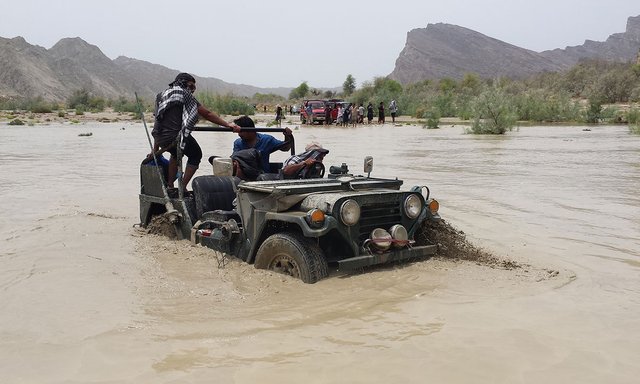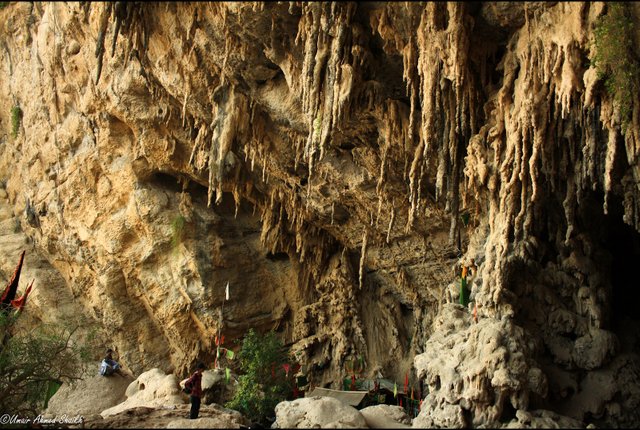Pakistan's Baluchistan area is talented with a differing scene. Among numerous geographical ponders here, one major fascination is the nearness of 18 mud volcanoes.

In fact world's biggest and most noteworthy known mud fountain of liquid magma is situated in Balochistan. The elevation of this most noteworthy mud well of lava is 300 ft. The mud volcanoes of Balochistan are situated on the land as well as every once in a while they show up as little brief islands in the Arabian Sea moreover.

To achieve the most acclaimed gathering of these mud volcanoes, one needs to travel west of Karachi on the Makran Coastal Highway (N10). The side road to the volcanoes is 38 km shy of Hungol (likewise articulated as Hingol) waterway. A 1×1 ft board here says 'Sapt Post'. Get off the street at this sign and take after the soil tracks towards Arabian Sea and you'll achieve the mud volcanoes.

The billboard photograph to one side above is where Makran Coastal roadway meets River Hungol.

7 out of the 18 mud volcanoes are found couple of kilometers from the Sapt post as specified above, where as rest of the 11 mud volcanoes are found further west amongst Kutch and Gwadar.

There are two known gatherings of mud volcanoes here. One is called "Chandargup" and other is called 'Jabl-ul-Ghurab'. Close to Chandargup is an old Hindu sanctuary called 'Hinglaj sanctuary' or 'Nani Temple'. There are numerous elocutions of the word Chandragup by and by. Because of closeness a Hindu sanctuary to these volcanoes,

it is likely that the word Chandargup is really gotten from the word 'Chandargupt'. Another word which locally says this gathering of volcanoes is 'Chandra coop' which implies Volcanoes of the Moon.

It is said that mud volcanoes have roots that go a few kilometers underground and go about as security valves for high underground weight.

The photograph to one side shows condensed mud streaming out of 300ft hight Chandargup well of lava in Hungol. It is said that liquified mud leaving the fountain of liquid magma has recuperating powers. Many individuals come here to utilize this mud to cure skin illnesses.

The most punctual record of the nearness of mud volcanoes in Balochistan goes back to 1840.

In 1862, Major (later Sir) Frederick John Goldsmid was utilized by the Governer of Bombay for unique missions. One such mission was an attack into Makran enduring from December 12, 1861 to January 1862.
The photograph to one side is the billboard on Coastal thruway N10 indicating bearing to old Hindu sanctuaries of Nani Mandir. The billboard is situated at the eastern bank of River Hungol connect.

Goldsmid and his gathering started their excursion overland from Karachi and composed a journal of their ventures upto Gwadar.
This travelog discusses the mud volcanoes, which gives the primary surviving record of their reality. In his diary Goldsmid expounds on going through percolating springs close Ras Koocheri, taking makeshift routes to see antiquated Hindu sanctuaries of Hinglaj and the mud volcanoes close Ormara. The Hindus adore these mud volcanoes as the home of a divinity Babhaknath.

It is accounted for that amid the scandalous 8.1 power quake of Balochistan which occured on May 31, 1935 a mud spring of gushing lava emitted Northwest of Quetta, close to the town of Surab and continued heaving out mud for 9 hours consistently.
Photograph to the correct shows particpants of 4×4 4x4 junkies club of Karachi with Chandragup mud fountain of liquid magma out of sight.

It is additionally revealed that on November 28, 1945 a seismic tremor of 7.8 power occured in Arabian Sea off the shoreline of Makran. The quake caused a tidal wave with a wave coming to as high as 13m at a few spots. This torrent slaughtered 4000 individuals off the shoreline of Arabian Sea in Sindh and Baluchistan. Broad devastation was accounted for in the towns of Pasni and Ormara.

The photograph to one side demonstrates a water lake shaped inside the pit of a mud well of lava. This photograph is from September 20016
A town called Khaddi got totally wiped off the substance of earth without any survivors. Indeed, even in Karachi, waves climbed a few feet through Clifton and Gizri. Ocean water entered the mixes of oil storerooms at Kimari harbor in Karachi. The submerged link interface which existed in 1945 amongst Karachi and Muscat was interfered.

The Cape Monze beacon, 72 km from Karachi, was harmed. The shake was likewise unequivocally felt at Manora Island close Karachi Harbor. The 94 feet high beacon on Manora island was harmed and two or three pounds of mercury spilt.
his quake shook and vented the mud volcanoes of Hungol so much that the gasses leaving this volcanoes got lighted and blazes climbed a few hundred feet noticeable all around.

The photograph to the correct demonstrates a ground level mud fountain of liquid magma close Gwadar.
The news of red hot volcanoes emitting in Balochistan (1945) spread crosswise over India. There were likewise reports from RAF air ship flying in from the west of volcanic emissions in Lasbela State in Balochistan. A Britisher named Peter Martin Kaye who was positioned at Korangi Creek Royal Air Force Flying Boat base and his companion Peter Woolf, who was additionally positioned at the Korangi Creek base, took two weeks leave from the construct authority and set off with respect to the second of December, 1945 on a campaign along the Makran Coast. They utilized camels given by the Wazir of Lasbela State as transportation.

Their central goal was to look at what had happened when the seismic tremor and torrent struck on Makran Coast. On achieving the area of three dynamic mud volcanoes (which they called Chandragup, Ranagup and Rajagup), reasoned that the shudder had discharged an amount of gas at that area which had touched off in a searing ejection offering ascend to the stories of volcanic emissions.

The photograph underneath is the perspective of Gwadar mud fountain of liquid magma in setting sun. Shadows have a place with the toursits. tapping on this photograph will take you to its parent site.
Another record of these emission originated from V.P. Sondhi, who in 1947 additionally expounded on the same volcanic marvel in the range close to the mouth of the Hungol River in Baluchistan following the 1945 tremor. As per Sondhi, the self-touching off crest of gas had emitted:

"with such awesome compel that the flares jumped a great many feet high into the sky."
V.P. Sondhi likewise recorded the rise of three mud fountain of liquid magma islands in the Arabian Sea simply off the shoreline of Makran. These seaward mud volcanoes didn't live long and the solid wave activity of Arabian Sea disintegrated the sloppy islands inside months. Before the finish of 1946 these mud volcanoes were totally gone.

Photograph to the correct shows hole edge of one of the Chandargup mud volcanoes.
The land investigate says that the mud volcanoes developing out of Arabian Sea are produced using exceptionally gooey mud with high gas content. The mud gets driven up by high lightness strengths and after some time, a high mud edge or mountain frames out of the water.

A researcher named G. Delisle had depicted in 2002 the development of another mud well of lava island in March 1999 at about a similar place, this time clearly not joined by a tremor, but rather it was additionally annihilated by wave activity a couple of months after the fact.
The photograph to one side shows winged creatures eye perspective of Hungol plain from top of one of the Chandargup mud volcanoes. A littler mud fountain of liquid magma is unmistakably obvious. This photograph is dated September 2005.
Mud volcanoes are for the most part not thought to be unsafe. In a few nations like Azerbaijan which has the biggest grouping of mud volcanoes on the planet, the gas emissions from mud volcanoes are more regular and savage than those in Pakistan, they are really a vacation spot. Should Pakistan do likewise?

With the opening of N10 – Makran Coastal Highway in 2004, mud volcanoes of Balochistan are currently inside couple of hours reach from Karachi.
Photograph to the privilege is a far off perspective of Chandargup mud fountain of liquid magma
The accommodation of a world class thruway is likewise bringing a steady stream of 'city slickers' to this once remote zone. Individuals are currently climbing onto these sandy volcanoes in expansive numbers. Some protection ought to be given to these characteristic ponders generally the assault of traveler will ruin the regular magnificence.
Tourism ought to be permitted however inside safe separation of these sandy landmarks. I likewise prescribe a visit to these volcanoes and also the delight of go on grand Coastal Highway, which merits a full post on its panoramic detour alone.
here im attaching a video of this mud volcano watch plz
Hope So you all like it

Whaaaaaat!?? Interesting!
Downvoting a post can decrease pending rewards and make it less visible. Common reasons:
Submit
yeah it is one of the rarest mud flow volcano here in Pak
Downvoting a post can decrease pending rewards and make it less visible. Common reasons:
Submit
Beautiful, keep sharing such posts to let the world know that our country is one of the coolest and awesome place to live.
Downvoting a post can decrease pending rewards and make it less visible. Common reasons:
Submit
thanks dear for your appreciation
Downvoting a post can decrease pending rewards and make it less visible. Common reasons:
Submit
Very interesting post!! Thank you!!
Downvoting a post can decrease pending rewards and make it less visible. Common reasons:
Submit